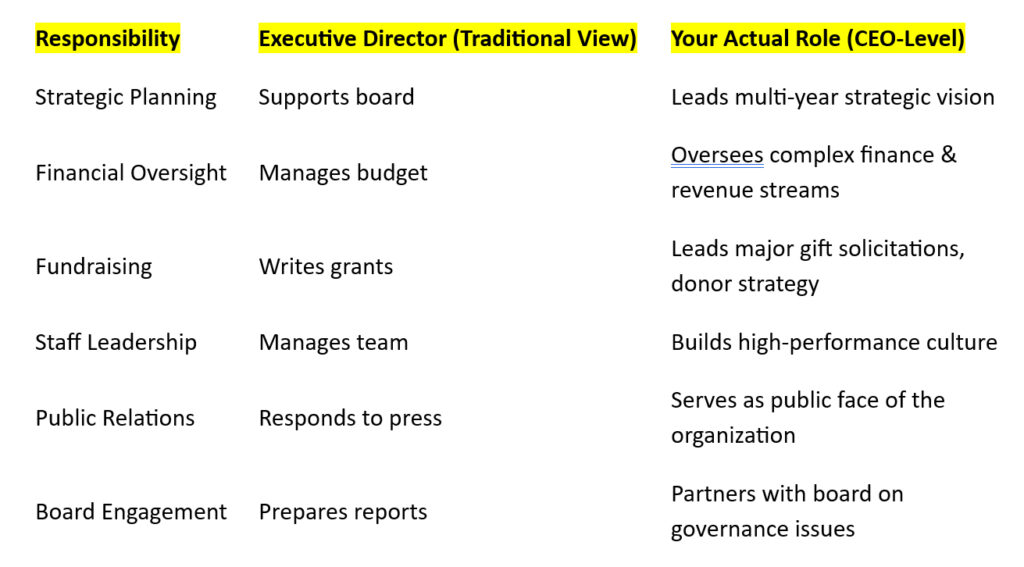
CEO vs. Executive Director – How Nonprofit Boards Are Strengthening Their Leadership
April 15, 2025
Fundraising is Sales – 8 Keys That Will Supercharge Your Success
April 17, 2025Executive Director vs CEO – How to Ask Your Board to Change Your Title!

If you’re an Executive Director leading a nonprofit organization with vision, excellence, and strategic savvy—but still carrying an outdated title—you’re not alone. Thousands of leaders across the nonprofit sector are running multimillion-dollar operations, building high-performing teams, and changing lives… all while holding a title that underrepresents their role.
You deserve more than recognition—you deserve accuracy. And that starts with a title that reflects your true scope of responsibility: Chief Executive Officer.
But how do you bring that conversation to your board? How do you shift perception without sounding self-serving? Here’s a step-by-step guide to help you lead that change with professionalism, humility, and strength.
1. Understand the Why Before You Make the Ask
Before approaching your board, get crystal clear on why this title change matters—not just for you, but for your organization.
You’re not asking for a title bump for prestige. You’re asking for alignment. You want your title to accurately reflect:
• The level of fiduciary and strategic responsibility you carry
• The public-facing role you play with donors, funders, and partners
• The leadership position you hold over staff, programs, and infrastructure
• The message it sends to stakeholders about the seriousness and professionalism of your enterprise
When you’re grounded in the purpose, your tone stays focused on the mission—not personal gain.
2. Gather the Facts: Show What CEOs Actually Do
Build a simple side-by-side comparison. Outline how your current responsibilities align more with that of a CEO than a traditional nonprofit Executive Director.
Here are just a few areas where your role likely mirrors a CEO:

Showing this comparison can help the board see the mismatch—and the solution.
3. Frame the Change as a Strategic Move for the Organization
Remind your board that this isn’t about ego—it’s about optics and effectiveness. Here are key talking points you can use:
• “Many of our peers in the sector have already made this shift. It aligns us with best practices in leadership.”
• “The CEO title creates clarity with external partners, funders, and major donors.”
• “It communicates to internal staff and future hires that we take leadership seriously.”
• “It aligns us more closely with the governance standards of for-profit boards, reinforcing our commitment to excellence.”
If your organization is entering a capital campaign, launching a major initiative, or applying for transformative grants—this is the perfect time to frame the title shift as part of your growth narrative.
4. Make It Easy for the Board to Say Yes
Your board likely wants to support you—they just need clarity and a low-friction path. So do the legwork. Have a board member share with your leaderships:
• A draft board resolution to officially adopt the title change
• A FAQ sheet addressing potential concerns (see below)
• Examples of other nonprofits of similar size who’ve made the switch
• A sample job description that reflects CEO-level responsibilities
You want this to feel like a natural evolution, not a jarring shift.
5. Anticipate and Address Common Concerns
You may hear a few objections. Here’s how to respectfully respond:
“Does this mean a raise?”
Not necessarily. “This is a title change only. Compensation decisions remain separate, and I’m not requesting any financial adjustments at this time.”
“Will this change our bylaws?”
Possibly. “In many organizations, the change can be made via board resolution. If our bylaws specify the ED title, we can amend them with a simple vote.”
“Will people think we’re becoming too corporate?”
No. “We’ll remain mission-driven. But this change strengthens our credibility and standing with business partners, donors, and other nonprofits.”
“Won’t this make the board seem less involved?”
Just the opposite. “It clarifies your role as governors and mine as manager of operations. That distinction helps us all lead more effectively.”
6. Use the Right Moment to Make the Request
Timing matters. Don’t drop this request in a rushed board meeting. Instead, consider:
• Presenting it during a strategic planning session
• Bringing it up during a board retreat
• Making it part of a leadership development update
• Framing it during the launch of a new initiative or capital campaign
You can even ask your board chair or a governance committee member to raise the topic on your behalf, which helps frame it as a board-driven conversation—not a personal agenda item.
7. Lead the Conversation with Confidence and Grace
When the moment comes, be direct and professional:
“I’d like to ask the board to consider updating my title from Executive Director to Chief Executive Officer. This change more accurately reflects the leadership responsibilities I’ve been entrusted with and better positions our organization for the future. It also aligns with sector best practices and helps us communicate our professionalism to funders and partners. I’m happy to answer any questions, and I’ve prepared a few materials to support your consideration.”
Then listen. Be open to feedback. Trust the respect you’ve built.
8. Read This Additional Article To Understand What We’re Telling Your Board
You’re going to want to read CEO vs. Executive Director – How Nonprofit Boards Are Strengthening Their Leadership. First, you need to know what we’re communicating to nonprofit boards. Second, you need to have one of your personal champions (a board member) send this article to your decisionmakers. The audience for this article is volunteers who lead organizations. This will prepare your way!
CEO vs. Executive Director – How Nonprofit Boards Are Strengthening Their Leadership.

Final Thoughts: You Deserve the Title You’ve Earned
You don’t need to wait 10 more years or raise $10 million before making this shift. If you’re already doing the job of a CEO, it’s time to be recognized as one.
Changing your title isn’t about vanity—it’s about clarity, positioning, and impact. The title “CEO” gives you the platform you need to lead boldly, raise more money, attract better talent, and expand your reach.
So stand tall. Prepare thoughtfully. MAKE THE ASK!
Your mission is worth it.
 Ask Your Board to Change Your Title from Executive Director to CEO was first posted at INSIDE CHARITY
Ask Your Board to Change Your Title from Executive Director to CEO was first posted at INSIDE CHARITY
For more articles like Ask Your Board to Change Your Title from Executive Director to CEO VISIT HERE
For more information on RE-IMAGINING NONPROFITS – TURN YOUR MESS INTO A MASTERPIECE by Louis Fawcett’s book VISIT HERE
